 |
February 2014
|
February 2014 // Volume 52 // Number 1 // Research In Brief // v52-1rb6
Use of Soil Tests for Residential Landscapes: A Survey of Soils Lab Open House Participants in Alachua County, Florida
Abstract
We discuss the results of a residential homeowners survey conducted at the Open House organized by the University of Florida's Extension Soil Testing Laboratory. For the majority of participants, the Open House provided the first opportunity to learn about the Soil Testing Laboratory services. Approximately half of the survey respondents who had never tested soils indicated that they had been unaware of the soil testing services or the organizations offered the service. Among those who had used the soil testing services prior to the event, more than one-third indicated that soil test recommendations are difficult to interpret.
Introduction
Although traditional predictive and diagnostic soil testing procedures have focused primarily on economic yield and/or quality of food crops and landscapes, present-day testing procedures emphasize simultaneous environmental sustainability. Therefore, a soil test becomes the first step when formulating a best nutrient management practice (Mylavarapu, 2009). The University of Florida, Institute of Food and Agricultural Sciences (UF/IFAS) Extension Soil Testing program promotes soil testing and administers standardized nutrient recommendations for all major crops, landscape plants, and lawns through soil testing services offered statewide via the county cooperative extension system. The UF/IFAS Soil Testing program subscribes to the "Crop Nutrient Requirement" philosophy for nutrient testing, interpretation, and recommendations, which ensures that nutrient applications are recommended only to meet the plant requirements (Hochmuth, Hanlon, Hochmuth, Kidder, & Hensel, 1992). The UF/IFAS Florida-Friendly LandscapingTM (FFL) program provides educational services that target residential households and landscape industry, promoting conservation of water, nutrients, and pesticides (FFL, 2010).
Complete guidance on soil testing (includes free sampling bags and boxes) for all residents statewide is available through Florida's 67 county Extension offices (Shober & Mylavarapu, 2012). Most of the test services through the Extension Soil Testing Laboratory (ESTL) are available for modest fees ($3–$10), with the standard landscape soil test providing macronutrient concentrations, pH and lime requirement (Mylavarapu, 2012a). Soil test results with appropriate lime and nutrient recommendations are available within 1 to 3 days of testing, via email, to both the client and the local county Extension faculty. Annual soil tests are generally recommended for residential households.
Soil testing has been promoted as a means for assessing soil fertility and productivity for over 50 years by UF/IFAS in Florida. Although concerted educational programs over the years have resulted in an increase in the number of residential samples submitted to the ESTL, from approximately 6,500 in 2009 to nearly 9,000 in 2012 (Mylavarapu, 2012b), previous research indicated that soil tests are neither widely used nor adopted by residential households without in-depth educational experience (Hefner, Robertson, Coulter, & Stevens, 2009; Israel, Easton, & Knox, 1999; Israel, Knox, & Brown, 1993). Consequently, increasing the use of residential soil testing continues to be a challenge. In an effort to further promote and expand the educational programs on soil testing for residential households, the ESTL organized an Open House on Saturday, April 14, 2012, on the UF main campus in Gainesville, targeting the residents of north central Florida, in preparation for the spring landscape season.
In addition to free soil pH tests at this event, the participants also learned about landscape maintenance and interacted with various UF/IFAS experts. The event was publicized via local newspapers and newsletters. A total of 84 participants attended. The event participants were surveyed with the objectives to:
- Determine the residents' awareness and appreciation of soil testing as a tool for managing their landscapes,
- Determine the barriers to both subscription and adoption of soil testing as a diagnostic tool for optimal landscape management by Florida residents, and
- Identify aspects of the educational services for improvement
Results obtained from the survey data are presented herein.
Methods
The survey instrument was structured into three sections. The first section included questions about respondents' demographics, home ownership, landscaping interests, and general attitudes towards environment. The second section included questions about prior use of ESTL services, the reasons for choosing soil tests, and use of the FFL principles. The final section asked about the reasons for not using ESTL services more frequently. The survey instrument was pre-tested and revised appropriately as per the feedback received from several faculty members and the ESTL staff.
The survey was distributed to the Open House event attendees, and of the 84 registered participants, 57 completed the survey (two surveys completed by commercial producers were excluded from this analysis). Frequency distributions and cross-tabulation (contingency tables) were used to examine responses; chi-squared and t-tests were used (SAS 9.2) to determine if survey responses to various questions were statistically independent.
Results
Characteristics of the Survey Respondents
Survey respondents included male and female Open House participants (Table 1), with the majority in the 45–64 years age group, who were highly educated (college degree), and long-time local residents (13.3 years average residency). The majority of respondents (more than 80%) reported having a combination of lawn grass and landscaped and/or native shrubs/trees in their yards. Only 1.8% of the respondents used a professional landscape service. Many respondents also reported growing vegetables (45.6%) and fruit trees (38.6%). Overall, the results are similar to conclusions from other studies showing the increase in interest in landscape maintenance and home gardens within this age group, suggesting that gardening and landscape work may be a priority for empty nesters and retirees (Borisova et al., 2012; Wilson & Newman, 2011; Bonneau, Darville, Legg, Haggerty, & Wilkins, 2009; Rohs, Stibling, & Westerfield, 2002; Schrock, Meyer, Ascher, & Snyder, 2000).
A large proportion of the respondents also supported creating a balance between natural resource use and environmental protection (42.3%), while 38.5% supported to various degrees of environmental protection (Figure 1). Awareness about environmental impact was high, a trend generally observed in this population (Hu, 2011), potentially increasing the willingness to use the scientific tools such as soil testing for reducing environmental impacts of yard management.
| Percentage of Respondents | |
| Gender | |
| Male | 43.9% |
| Female | 56.1% |
| Age | |
| 18 to 24 years old | 0% |
| 25 to 44 years old | 12.3% |
| 45 to 64 years old | 54.4% |
| 65 years old and older | 33.3% |
| Educational attainment | |
| Some high school | 0% |
| Completed high school or GED | 1.8% |
| Some college | 22.8% |
| Completed 4-year college degree | 31.6% |
| Completed graduate or professional degree | 43.9% |
Figure 1.
Response to the Question: "How do you see yourself on environmental issues?" (N = 57)
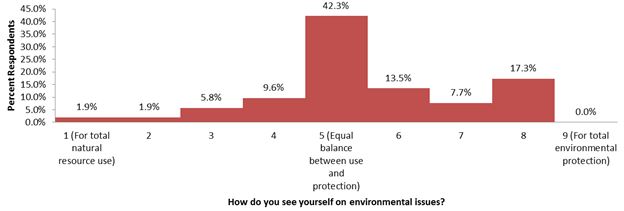
Reasons for Attending the Open House Event
Almost all respondents (96.5%) indicated that they had brought a soil sample to the event to avail the free soil pH test offer. However, only 42.1% indicated soil testing as the primary reason for their participation (Figure 2). The data suggested that while publicized, "free" soil pH tests possibly attracted a majority of the participants, it was the simultaneous access to the specialists and the related educational information that further influenced participants' decision to attend.
Figure 2.
Aggregated Response Categories for the Open-Ended Question About Primary Reasons for Attending the 2012 Soils Lab Open House Event*

* Note that a few respondents indicated several reasons; the percentages do not add up to 100%
Prior Use of Soil Test Services
Overall, only 17 respondents (30%) indicated that they had ever used soil test services. Characteristics of these respondents, as described above (Table 1), were comparable with the rest of the participants (based on chi-square and t-tests at 95% confidence level). The data strongly indicated that the event, design, and publicity had attracted people never previously exposed to the ESTL services and that the methods used had reached newer audiences, thus widening the program's impact.
A large proportion of the 57 survey respondents answered that they had used one or more FFL principles in their yard (63.2%). The FFL program promotes the use of soil tests, and the use of soil testing was slightly higher among those who reported using FFL principles (i.e., 33% among those who used FFL, compared with 21% among those who did not). However, the difference was not statistically significant, possibly due to the overall small number of responses in each category (chi-square test, 95% confidence level). Because both the UF/IFAS nutrient management and the FFL programs share the common goals of optimizing nutrient efficiencies and minimizing negative environmental impacts, it is imperative that the programs offer educational events together and promote the ESTL tools and services as a means to achieve these goals.
A majority of the 17 respondents who had previously used the soil test services tested the pH/lime requirement every 2–3 years (Figures 3 and 4), and their primary reason for soil testing was to verify the optimal lime requirement for their landscapes (Figure 5). Approximately half of respondents requested soil tests to determine what plants were best suited for their soils. However, soil tests should not be perceived as a silver bullet for matching plants to the local soils; there is also a need for education on clarifying the limitations of soil tests. The fact that soils in the yards can be managed in several ways to suit the residents' plant choices (as long as the management does not involve changing inherent soil properties) should be emphasized. For example, soil pH can be managed to suit a reasonable acid-alkaline range based on plant tolerance. Some temporary ecosystems such as xeriscapes and moisture regimes can be designed and created to suit the plants.
Only a third of the respondents opted for "saving money by reducing lime / fertilizers use," making it the least important reason for soil testing, which suggests that the expense of yard management may not be the limitation for yard management choices.
Figure 3.
Types of Soil Test Requested (percent respondents)
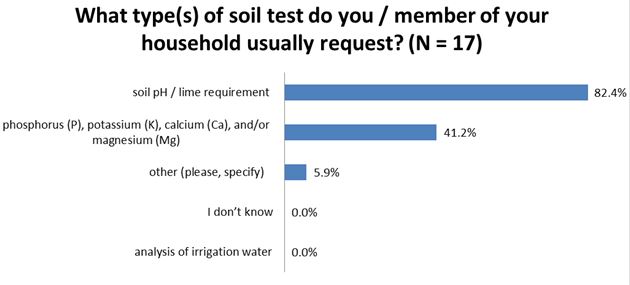
Figure 4.
Frequency of Soil Testing (percent respondents)
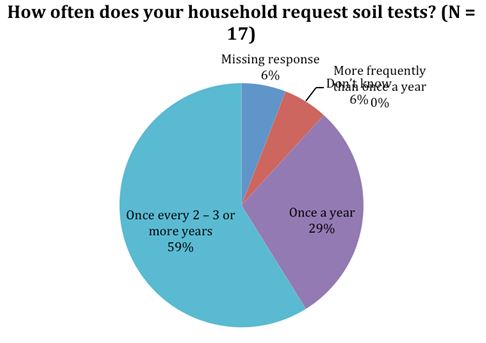
Figure 5.
Primary Reasons to Use Soil Testing Services (percent respondents)
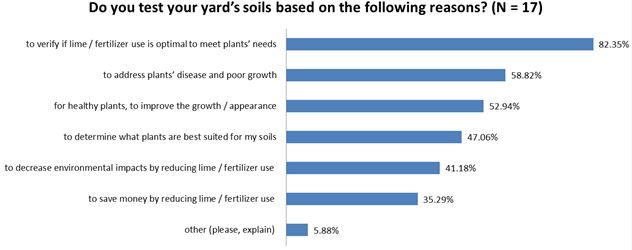
Barriers for the Use of Soil Test Services
The reasons for not using soil test services more frequently depended on whether or not respondents had previously tested their soil samples (chi-square test, 99% confidence level). Approximately half of the respondents who had never used soil test services before indicated that they lacked information about soil test services or about the organizations performing soil tests (Figure 6). While about a third of the respondents stated the difficulty in interpreting the test reports as a barrier, some indicated other reasons such as "inertia," "[being] lazy," or "inconvenience involved." Comments also point out possible confusion about the necessary frequency of testing ("not sure how often I should test" and "[the results] don't change often"). More aggressive promotional activities are necessary to significantly enhance the impact of the program. County Extension agents and Master Gardeners can be further trained to provide additional guidance, because the soil test information can be too technical. Publicizing ESTL services, emphasizing the importance of soil testing, designing user-friendly interpretations of test results, and simplifying access can potentially increase the utilization of ESTL services.
Figure 6.
Primary Reasons to Not Use Soil Testing Services More Frequently (percent respondents)
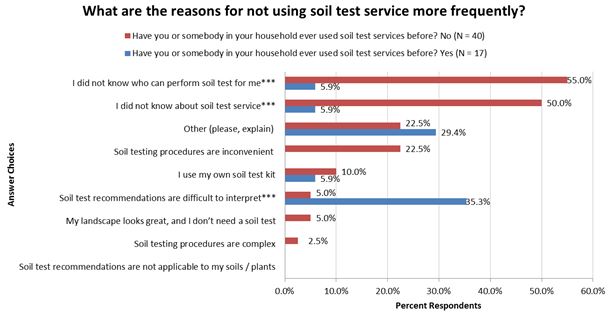
*** Responses are significantly different between the groups of respondents who had / had not use soil tests before the Open House event (99% confidence level, chi-square test)
Conclusions
In the study reported here, we focused on the Extension Soil Testing Program and surveyed the residential households that attended the Soil Lab Open House event to understand the underlying motivation and primary barriers for using the program. The following three main conclusions can be drawn from the study.
- Individual motivations and ability to use soil test services vary among residential households. Among those who had used soil tests before, 41% did so to decrease environmental impacts. Moreover, approximately 39% of survey respondents to various degrees supported the idea of environmental protection. These data suggest that targeted campaigns addressing the specific audience concerns, such as soil tests, as a tool to minimizing negative environmental impacts and/or enhancing nutrient and water efficiencies and/or developmental planning can be highly effective.
- Seventy percent of the survey respondents had never used soil testing services prior to the Open House event, and approximately half of them indicated lack of awareness about the soil testing services and the providers as the primary reason. Although soil testing services are widely available and have been immensely popular for decades with the agriculture industry, our survey shows that residential households are still unaware of them. The event, therefore, attracted new residential households previously not reached. The survey strongly indicated that the soil testing services should be reinforced to make them more effective, user-friendly, comprehensive, highly accessible, and technologically appropriate for non-technical clientele.
- Several respondents indicated seeking information on better plant care, UF/IFAS ESTL services, and environmentally sustainable practices as the reasons for attending the Open House event. The survey revealed the need for soil testing and the need for providing all related aspects of landscape management at one location simultaneously.
The survey shows that Master Gardeners and county Extension agents should be exposed to the knowledge gained from this event and this survey and should be trained further to overcome the barriers identified. While the study at a single event revealed much information regarding the use of soil tests, a series of public focus group studies in different regions of Florida will possibly help better understand the use of ESTL programs among diverse audiences.
Acknowledgments
We acknowledge the help from all the staff members of the UF/IFAS ESTL; all the IFAS programs represented; Greg Means, Biologist, Soil & Water Science Department; Boaz Anglade, graduate student; and Carol Fountain, editor, Food and Resource Economics Department, University of Florida
References
Bonneau, L., Darville, R., Legg, M., Haggerty, M., & Wilkins, R. (2009). Changes in volunteer knowledge and attitudes as a result of Texas Master Naturalist Training. Human Dimensions of Wildlife, 14:3, 157-172.
Borisova, T., Adams, D., Flores-Lagunes, A., Smolen, M., McFarland, M., & Boellstorff, D. (2012). Does participation in volunteer-driven programs change household landscape management practices? Evidence from southern states. Journal of Extension [On-line], 50(3), Article 3RIB4. Available at: http://www.joe.org/joe/2012june/rb4.php
Florida-Friendly Landscaping™ Program (FFL). (2010). The Florida Yards & Neighborhoods (FYN) Homeowner Program. Retrieved from: http://fyn.ifas.ufl.edu/homeowner.htm
Hefner, S. G., Robertson, C., Coulter, A., & Stevens, G. (2009). Engaging citizens to urban nutrient planning of lawns within a nutrient sensitive watershed. Journal of Extension [On-line], 47(4), Article 4IAW5. Available at: http://www.joe.org/joe/2009august/iw5.php
Hochmuth, G., Hanlon, E., Hochmuth, B., Kidder, G., & Hensel, D. (1992). Field fertility research with P and K for vegetables—interpretations and recommendations. Soil & Crop Science Society of Florida, 52, 23-25.
Hu, Z. (2011). Water quality perceptions in the US. Ph.D. Dissertation, Department of Sociology, Iowa State University, Ames, IA, 106p.
Israel, G. D., Knox, G. W., & Brown, S. P. (1993, September). Using environmental landscape management practices: An exploratory program assessment. Bulletin 287.University of Florida Cooperative Extension Service, Gainesville, FL.
Israel, G. D., Easton, J. O., & Knox, G. W. (1999). Adoption of landscape management practices by Florida citizens. HortTechnology, 9(2), 262-266.
Mylavarapu, R.S. (2009). Diagnostic nutrient testing. HortTechnology, 20, 19-22.
Mylavarapu, R. S. (2012a). Landscape and vegetable garden test information sheet. Electronic Data Information Source (EDIS) SL136. University of Florida, Gainesville, FL.
Mylavarapu, R. S. (2012b). Extension soil testing laboratory sample summary. LIMS, Analytical Services Laboratory (ANSERV Labs), Soil & Water Science Department, University of Florida, Gainesville, FL.
Rohs, F., Stibling J., & Westerfield, R. (2002). What personally attracts volunteers to the Master Gardener Program? Journal of Extension (On-line], 40(4), Article 4RIB5. Available at: http://www.joe.org/joe/2002august/rb5.php
Schrock, D., Meyer, M., Ascher, P., & Snyder, M. (2000). Reasons for becoming Involved as a Master Gardener. HortTechnology, 10(3), 626-630.
Shober, A. L., & Mylavarapu, R. S. (2012). Soil sampling and testing for the home landscape or vegetable garden. Electronic Data Information Source (EDIS) SL281. University of Florida, Gainesville, FL.
Wilson, J. C., & Newman, M. E. (2011). Reasons for volunteering as a Mississippi Master Gardener. Journal of Extension [On-line], 49(5), Article 5RIB1. Available at: http://www.joe.org/joe/2011october/rb1.php




